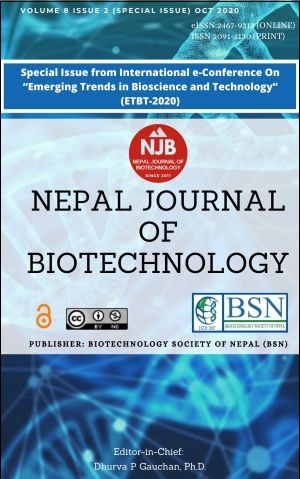Comparative Assessment of Antibiotic Resistance in Lactic Acid Bacteria Isolated from Healthy Human Adult and Infant Feces
DOI:
https://doi.org/10.3126/njb.v8i2.31893Keywords:
Lactic acid bacteria, Antibiotic resistance, lactobacillus, Feces, Fecal microbesAbstract
Lactic acid bacteria are normal inhabitants of the gastrointestinal tract of humans. Their occurrence in infant and adult feces is abundant. The current study assesses and compares the antibiotic resistance in lactic acid bacteria isolated from healthy human adult and healthy infant fecal samples. A total of 255 lactic acid bacteria isolates (126 from adult feces and 129 from infant feces) were isolated and characterized from 60 fecal samples. Lactobacillus spp., Pediococcus spp. and Enterococcus spp. were included in the study. The study was done using the WHONET software for the analysis of antibiotic susceptibility data of lactic acid bacteria. Most of the Lactobacillus and Pediococcus strains were sensitive to vancomycin. Enterococcus strains showed resistance against vancomycin. Ampicillin, ciprofloxacin and cefuroxime resistance were significantly (p<0.05) higher in Lactobacillus strains isolated from adult fecal samples than those isolated from infant fecal samples. A similar pattern was observed in Enterococcus strains with erythromycin, gentamycin and tobramycin resistance. Pediococcal isolates from adult feces showed significantly higher resistance against tobramycin, ciprofloxacin, gentamycin, cefotaxime and cefuroxime in comparison with infant fecal isolates. Antibiotic resistance was exhibited by lactic acid bacteria against most commonly used antibiotics and it was higher in strains isolated from adult fecal samples than in the strains isolated from infant fecal samples. The increasing trend in antibiotic resistance from infant to adult might be due to food habits and antibiotic intakes. Thus, the widespread antibiotic resistance in different lactic acid bacteriamay pose a food safety concern as well.
Downloads
Downloads
Published
How to Cite
Issue
Section
License
Copyright Notice:
The manuscript submitted to NJB must be an original contribution, not previously published and should not be under consideration for publication elsewhere. When the manuscript is accepted for publication, the authors agree to automatically transfer the copyright of the article to the publisher. It should grant permission to any third party, in advance and in perpetuity, the right to use, reproduce or disseminate your article, according to the NJB copyright and license agreement.
Authors transfer copyright to the publisher as part of a journal publishing agreement but have the rights to: Share their article for Personal Use, Internal Institutional Use and Scholarly Sharing purposes, with the NJB applies the Creative Commons Attribution-NonCommercial CC BY-NC license to all the works we publish after Jun 2020 (Before it was CC BY-NC-ND). Under this license, authors agree to make articles legally available for reuse, without permission or fees, for virtually any non-commercial purpose. Anyone may remix, adapt, and build upon your work non-commercially, and although their new works must also acknowledge you and be non-commercial, they don’t have to license their derivative works on the same terms. More details on CC BY-NC refer to its Licence Deed and Legal Code.






